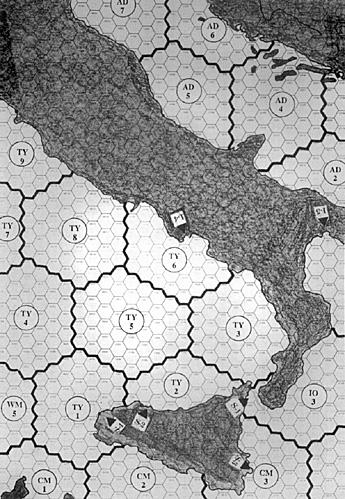I have a final thought on merchant ships and destroyer squadrons, again in the spirit of simplifying and making naval action more realistic. Supermarina states that one naval transport point (NTP) equals 5,000 gross register tons (or 500,000 cubic feet of cargo space). This equals one RE, and is also equivalent to one medium-sized ship of that era. It is a very abstract measure and maybe something better can be devised. Plenty of coasters and landing craft fall below 1,000 tons, but liners and tankers of the time weighed in at 20,000 tons or even larger. While we can picture a sub sinking 5 coasters as the equivalent of one medium ship (though this means five torpedoes, not one), we have no way to sink 1/4 or 1/5 of a troopship.
Supermarina took an approach that was similar to air transport; treat multi-RE cargoes as being destroyed if any one of the supporting NTPs is lost. Thus if we torpedo any one NTP, the entire supply step or c/m regiment or whatever being transported by it and the other NTPs is lost. This is contrary to the established practice of distributing loads and cargo types among ships in a large convoy, and at the same time suggests the image of the ship's hull splitting open, the cargo spilling out, and the mangled remaining 3/4ths of the ship safely making port. It's not a really big problem, but it is a problem. I suggest that we reform this approach.
First, pick a larger number as the basic unit of accounting. Given that ratings for Europa ports are in multiples of 5, the proper size for a transport marker is probably 5 REs, or 5 Supermarina-sized NTPs. This aggregate of 25,000 GRT can be more than a generic counter. The big troopships will have a counter all to themselves, and can be rated for their high speed, their exact capacity, and even have a roster for hits like the combat ships do. The medium ships, coasters and landing craft, which might number from 5 to as many as 40 per counter, can be given a bonus for dispersal, better or worse AA, and resistance to torpedo attacks.
When damaged, they can flip to a 2-RE "cadre". Since merchant ships and small transport craft typically do not possess primary, secondary, or tertiary gunnery factors, only one side of the standard Europa counter is needed for them; the flip-side cadres would also be fine for delivering cargo to minor ports.
Second, for transport counters possessing a .cadre", implement a separate loss check procedure for each item of cargo carried, based on the severity of the hit. If the 5-NTP counter is only reduced to cadre, and it is carrying a mixture of 1-RE or 2-RE cargos, some cargo should get through intact; if the cargo is, say, a division, there should also be a chance for it to be cadred as well, instead of eliminated.
Instead of 437 Italian NTPs (in Supermarina), colorless and generic, we could have 80 to 90 transport counters, individually rated for speed and payload, from tankers to merchant cruisers. The research need only be done, and maybe some day I'll have time to do it myself. I look forward to the day when we can fight out each convoy action off Malta in its historical form, and yet still have time to concentrate on the land game. And that's what this naval system is intended to accomplish.
Here I'd like to bring my thesis on sea zones and the Europa naval game to a close, focusing on the note of economy--both play sequence economy and counter economy. It is this problem of economy that plagues me. If, as several people have commented, it is impossible to play even four game years of FitE/SE in under five real years, what prospects have we for playing the naval game (to say nothing of Grand Europa)?
At present, given Supermarina, we would have to plot the exact movements, ammunition status, fuel status, and damage condition of every destroyer and cruiser and sub and torpedo boat and medium-sized merchant ship, on each individual day of the war, to within 13 nautical miles of its actual track-yielding a total of more than 2,000 British naval movement phases, with the British player alone controlling anywhere from a dozen to several thousand ships-averaging at least 300 individual ships from day to day.
The approach I've outlined here reduces most ship counts by a factor of 5, and movements by a similar amount- from 600,000 British moves, totalling 12 million hexes counted out, to a mere 24,000 moves through a few hundred thousand sea zones. By contrast, moving 2,000 Soviet counters during a four-year game of FitE/SE takes (I'm guessing) about 200,000 moves and maybe a million hexes counted. (My God, a million hexes.)
Is a goal of 24,000 moves low enough? Could naval Grand Europa now be playable? I don't know, but I'm sure there are readers out there with opinions.
This brings my thesis on sea zones and the Europa naval game to a close. As I've said, I welcome comment or criticism, particularly if you write to the magazine in favor of the general concept.
Map

The Case for Sea Zones The Europa Naval Rules Get a Refit
- Introduction
Part 1: Why Sea Zones Should Be Time-Graded (and Fixed-Radius)
Part 2: The 3-Naval-Phase Sequence of Play
Part 3: The 61-Hex Sea Zone
Conclusion
Back to Europa Number 25 Table of Contents
Back to Europa List of Issues
Back to MagWeb Master Magazine List
© Copyright 1992 by GR/D
This article appears in MagWeb.com (Magazine Web) on the Internet World Wide Web. Other articles from military history and related magazines are available at http://www.magweb.com